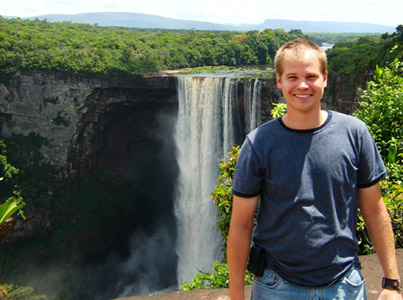Reining in rampaging algae

Apurva Gollamudi
Although winter's bludgeon has made the promise of summer seem a cruel joke, within a matter of months many Quebecers will be beating the heat by plunging into one of the province's many lakes. That is, of course, unless their favourite waterhole has been shut by bluegreen algae, the headline-making scourge of Quebec summers that can choke a lake with its relentless growth. At its worst, blue-green algae, or cyanobacteria, can produce a variety of toxins that can literally poison lake water.
Mark Eastman spent this past year doing research for his just-submitted Master's thesis on four farms on the Pike River watershed of the Missisquoi Bay region of southern Quebec – the front lines of the blue-algae battlefield. The watershed empties into Lake Champlain, "a lake that has suffered outbreaks of cyanobacteria every summer since the late 1990s," Eastman said.
As with all armies, cyanobacteria, is only as good as its food supply – feed it well and it will leap from lake to lake at an alarming rate. Knowing this, Eastman spent his summer knee-deep in the algae's favorite fare, nitrogen and phosphorous (both found in abundance in livestock manure) charting nutrient runoff at the four sites.
Once collected, the data was plugged into a computerized watershed model that allowed Eastman to predict what management practices could be employed to help reduce the nutrient runoff and, it is hoped, help curb the spread of the algae. "We were able to change things like drainage depth and spacing, change the tilling depth or the amount of organic matter content in the soil in the models rather than implementing them in the field," said Eastman. "It saved us a lot of time and money."
Eastman, who grew up on a small familyrun pig farm in southwestern, Ont., helped farmers reduce the nutrient content going into the field and the amount of phosphorous they bought. He has also supplied the Quebec government with data that may influence future policy decisions.
Although last year was the first year in which Lake Champlain avoided the annual cyanobacteria onslaught, Eastman is not about to claim victory. Yes, the farmers from his sites reduced the level of phosphorous in their runoff, but the levels of phosphorous in the lake were very similar to past, algae-choked years.
"It makes us question whether or not phosphorous is driving these outbreaks – something a lot of people have assumed for a long time," said Eastman. "But there are so many factors. Maybe nitrogen plays a bigger role. The winds were down last year so the lake didn't get churned up as much and light intensity was up. Obviously, this is an ongoing issue."

